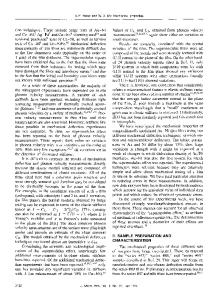Nanoindentation Measurements of Mechanical Properties of Polystyrene Thin Films
- PDF / 62,638 Bytes
- 6 Pages / 612 x 792 pts (letter) Page_size
- 49 Downloads / 343 Views
Nanoindentation Measurements of Mechanical Properties of Polystyrene Thin Films Min Li, C. Barry Carter, and William W. Gerberich Department of Chemical Engineering and Materials Science, University of Minnesota, Minneapolis, MN 55455 ABSTRACT The elastic modulus and work of adhesion of thin polystyrene (PS) films have been evaluated from nanoindentation load-displacement curves. The modulus was calculated using two methods: an unloading stiffness analysis and an elastoplastic unloading analysis. Results indicate that the latter analysis gives better modulus evaluation for the polymers. Two methods were also utilized in determining the work of adhesion, one using the pull-off forces and one using the displacement difference at zero force and pull-off force. The values given by the two methods are close. The effects of surface roughness and maximum load on the adhesion measurements are discussed. Different molecular weights were also chosen to compare the characteristics of the polymers during use under the same conditions. No significant difference in either modulus or adhesion energy was shown between the PSs of very low, moderate, and high molecular weights at room temperature. INTRODUCTION Polymeric films as conductors, resistors, and especially insulators are used everyday for the fabrication of microelectronic devices. Generally, besides having good electrical properties, these films must also have good mechanical properties, good adhesion to various substrates, and good thermal stability, to avoid failure. Nanoindentation is now widely utilized in evaluating thin-film mechanical properties, such as modulus, hardness, and adhesion. A number of techniques [1-3] have been developed towards the goal of evaluating the elastic modulus of thin films from nanoindentation load-displacement curves. For nanoindentation into polymeric materials, pull-off forces are often observed near the end of the unloading portion of the loaddisplacement curves. From the value of this pull-off force, the adhesion strength of the surface can then be evaluated according to JKR theory [4]. In the present study, we used a depth-sensing nanoindentation instrument to measure the mechanical properties of thin polystyrene (PS) films. A number of mechanical properties of polymers, including softening temperature, hardness, and fatigue resistance, are affected by molecular weight. Thus, PSs of different molecular weights were chosen and tested at room temperature to compare their characteristics during use under the same conditions. EXPERIMENTAL The PSs used in this study were prepared by anionic polymerization. Their values of glass transition temperature Tg were calculated according to [5] Tg = Tg∞ − k M n . (1) Here, Tg∞ is the value of Tg at infinite molecular weight, and k is a constant. For polystyrene, Tg∞ is 100 °C and k is about 1.75×105 [6]. The molecular weight and calculated Tg values are Q7.21.1
Table I. Properties of the polystyrenes used in this study. Mn (g/mole) Tg (°C)
1,510 -16
Polystyrene (PS) 48,400 96
189,000 99
liste
Data Loading...










